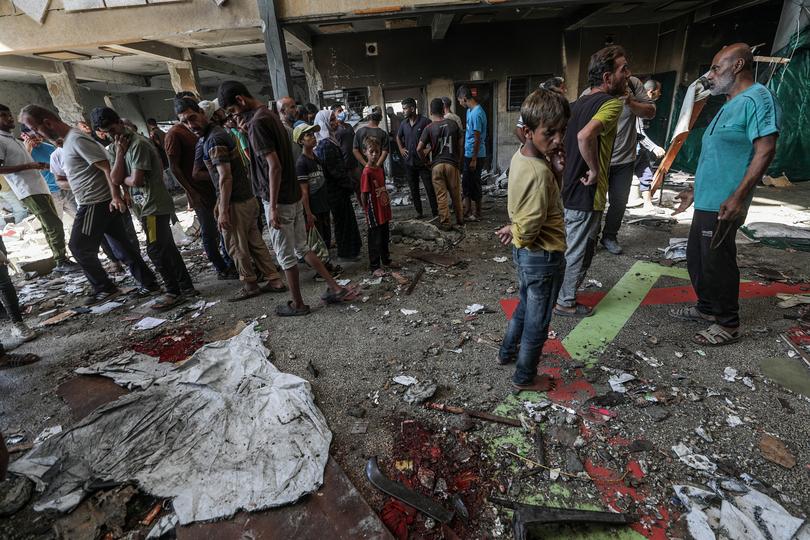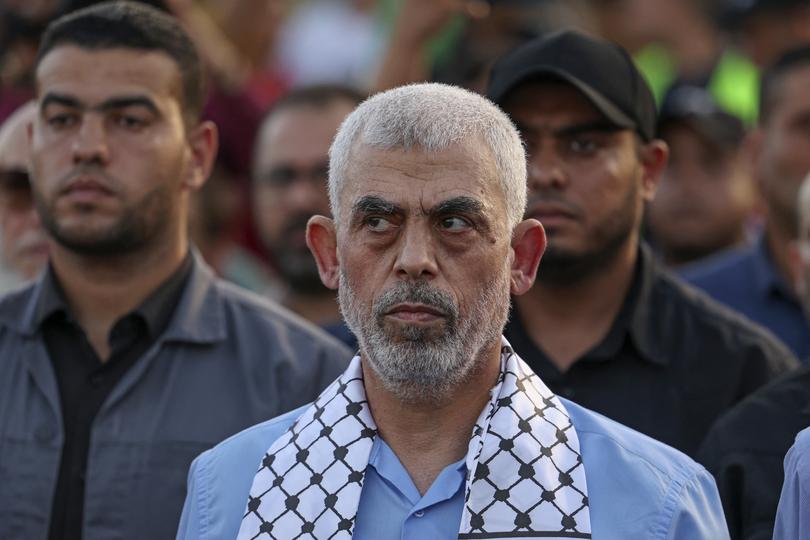Captured documents reveal Hamas’s broader ambition to wreak havoc on Israel

Years before the October 7, 2023, attack, Hamas’ leaders plotted a far deadlier wave of terrorist assaults against Israel — potentially including a Sept. 11-style toppling of a Tel Aviv skyscraper — while they pressed Iran to assist in helping achieve their vision of annihilating the Jewish state, according to documents seized by Israeli forces in Gaza.
Electronic records and papers that Israeli officials say were recovered from Hamas command centers show advanced planning for attacks using trains, boats and even horse-drawn chariots — though several plans were ill-formed and highly impractical, terrorism experts said. The plans anticipate drawing in allied militant groups for a combined assault against Israel from the north, south and east.
The trove of documents includes an annotated, illustrated presentation detailing possible options for an assault as well as letters from Hamas to Iran’s top leaders in 2021 requesting hundreds of millions of dollars in funding and training for 12,000 additional Hamas fighters.
Sign up to The Nightly's newsletters.
Get the first look at the digital newspaper, curated daily stories and breaking headlines delivered to your inbox.
By continuing you agree to our Terms and Privacy Policy.It is unclear whether Iran knew of the planning document or responded to the letters, but Israeli officials view the requests as part of a larger effort by Hamas to draw its Iranian allies into the kind of direct confrontation with Israel that Tehran has traditionally sought to avoid.
The 59 pages of letters and planning documents in Arabic obtained by The Washington Post represent a fraction of the thousands of records that Israel Defense Forces say they have seized since Israel’s ground invasion of Gaza began October 27.

The decision to release the documents comes at a time when Israeli leaders are weighing a possible retaliatory strike after Iran launched more than 180 ballistic missiles against Israel on October 1, in response to Israel’s Sept. 27 killing of Hasan Nasrallah, the Shiite cleric and leader of Lebanon’s Hezbollah militant group.
“Hamas is so determined to wipe Israel and the Jewish people off the map that it managed to drag Iran into direct conflict — under conditions that Iran wasn’t prepared for,” said an Israeli security official who has reviewed the letters and planning documents.
The official, like others interviewed, spoke on the condition of anonymity to discuss sensitive documents seized by Israeli forces in Gaza.
President Joe Biden on Wednesday said the United States supports Israel’s right to defend itself “against Iran and all its proxies — Hezbollah, Hamas and the Houthis.”
“We’re doing everything we can to ease the suffering of all the people from this war against Hamas and that Hamas started,” Biden said at a White House meeting with Jewish religious leaders.
In the letters written in 2021, Hamas’s Gaza leader Yahya Sinwar mounts a vigorous appeal to several senior Iranian officials — including the country’s supreme leader, Ali Khamenei — for additional financial and military support, pledging that, with Iran’s backing, he could destroy Israel completely in two years.
“We promise you that we will not waste a minute or a penny unless it takes us toward achieving this sacred goal,” states a June 2021 letter with apparent signatures by Sinwar as well as five other Hamas officials.
In the letters, Sinwar does not provide details of how he intended to destroy Israel. Israeli and other Middle Eastern officials say Tehran was surprised by the attack on October 7, and angry at Sinwar for not revealing his intentions in advance.
But they contend that both Iran and its Lebanese proxy Hezbollah knew that Hamas was making preparations for a major assault.
“It was their shared strategy to attack Israel,” one analyst said.
US and Israeli analysts believe that Iran provided hundreds of millions of dollars to Hamas’s military wing and increased its support in 2023.
Tehran declined to involve itself directly in Hamas’s fight after the Oct. 7 assault on southern Israel. Since then, as the conflict expanded to include Hezbollah rocket attacks on northern Israel and IDF strikes on Lebanon, Syria and Yemen — and, in recent weeks, a land invasion of southern Lebanon — Iran has been pulled ever deeper into the conflict, including with two massive aerial assaults on the Jewish state.
Israel’s war in Gaza meanwhile has killed more than 42,000 people, according to the Gaza Health Ministry, which does not distinguish between civilians and combatants but says the majority of the dead are women and children.
In Lebanon, the death toll is more than 2000 and growing.
While the documents’ authenticity could not be definitively established, the contents are broadly consistent with US and allies’ post-Oct. 7 intelligence assessments about Hamas’s long-range planning and complex relations with Iran.
US intelligence agencies have seen some of the captured Hamas documents, and The Post shared copies of its documents with several US officials, none of whom expressed concern about their authenticity but declined to comment publicly.
The Post also spoke to Israeli officials at other agencies that were not involved in acquiring the documents, who independently assessed that they were genuine.
Iran’s mission to the United Nations, in response to questions from The Post, did not address specific allegations but accused Israel of spreading disinformation.
“We regard the Israeli regime as a mendacious criminal, anti-human entity and place no credence in their illusions,” a spokesman for the mission said.
“They have a long history of spreading falsehoods, fabricating already-counterfeit documents, and conducting deceptive psychological operations.”
Basem Naim, a senior Hamas official, declined to comment on the contents of the letters and records but said that Israel has a history of fabricating documents.
Hamas’ October 7 attack, planned over many months amid extreme secrecy, called for simultaneous breachings of the Gaza perimeter wall by an estimated 6,000 fighters who rampaged nearby Israeli military bases, towns and kibbutzim, killing more than 1200 people and taking some 250 hostages.

The attack, the brainchild of Sinwar and other leaders of Hamas’s Gaza military wing, was the deadliest assault against Jewish civilians since the Holocaust.
But, in the months preceding the attack, Hamas envisioned going much further, a planning document suggests.
A 36-page computer slide presentation created in late 2022 and discovered at a Hamas outpost in northern Gaza on November 10 lays out options and scenarios for attacking Israel across multiple fronts, with targets ranging from military command centers to shopping malls.
The Arabic document, titled, “Strategy to build an appropriate plan to Liberate Palestine,” contains dozens of maps, photographs and schematics depicting the movement of Hamas fighters against Israeli targets, and a possible sequence for attacks.
“We present to you this vision, which talks about the appropriate strategy for liberation in the near future, God willing,” the presentation’s preamble states.
According to the presentation, the attack plans were based on a “large database” that included more than 17,000 photographs - from satellite images to photos of Israeli cities and landscapes taken by drone cameras or gleaned from social media postings.
Among the images displayed are the layouts of Israeli air bases and military installations and diagrams showing the flight patterns of commercial aircraft using Ben Gurion International Airport outside Tel Aviv.
The presentation outlines three possible attack vectors, and suggests tactics to deceive Israeli security officials and confuse their response.
The plans include a mix of low-tech operations, some of which were used on Oct. 7, and others that appear to be more aspirational.
Among the latter was a plan to destroy a Tel Aviv skyscraper. The document identifies as possible targets the Moshe Aviv Tower, a 70-story building that is Israel’s second tallest, as well as the Azrieli Center complex which comprises three skyscrapers, a large shopping mall, train station and cinema.

The plan notes the nearby presence of the IDF headquarters building and suggests that the collapse of a nearby high-rise could crush the military facility as well.
But Hamas had apparently not figured out exactly how the buildings might be taken down, the document acknowledges. “Working to find a mechanism to destroy the tower,” it states.
A more practical target, Hamas believed, was Israel’s rail system.
The document describes several variations of a plan to use railways to transport fighters and powerful explosives - including fuel tankers that could be detonated with small bombs — in Israel’s largest city.
“The railway line is designated for transporting fuel, which is a weak point in the event of a train explosion after moving inside one of the cities (a moving bomb),” it states.
Other plans called for modifying vehicles so they could travel on rails, and turning fishing vessels into high-speed attack boats to carry fighters and explosives into Israeli ports. Referring to the boats-as-bombs plan, the document said Hamas had already “found a mechanism that works.”
Perhaps the most unusual proposal was a plan to resurrect the horse-drawn carriages of antiquity as modern conveyances for fighters and weapons.
The presentation includes photographs and descriptions of a three-man chariot drawn by horses that can cross rugged terrain with ease.
A chariot would offer a “fast and light mechanism” that emits little heat or sound compared with a motorcycle — a vehicle that Hamas fighters used in abundance in the Oct. 7 attack.
“It carries three people, one of whom is free to drive and the other two to shoot and fight,” the document says of the chariots.
Implicit in the plan is the conviction that Hamas’s closest allies would fully join the fight after noting the successes of the group’s initial forays into Israel.
US and Israeli officials believe that Sinwar, who declined to share details of the October 7 plan with Hezbollah or Iran’s Islamic Revolutionary Guard Corps in advance of the attack, convinced himself that a Hamas attack on Israel would spark a broader war that both groups eventually would be compelled to join.
An essential part of any operation, the document says, would be “linking and preparing the external fronts (Lebanon, Syria, and Sinai) and agreeing on mechanisms for communicating peacefully and in war.”
Hezbollah did begin firing rockets into northern Israel on October 7, 2023, barrages that inflicted hundreds of casualties and prompted the evacuation of nearly 100,000 Israeli civilians. But the militant group — assessed to have tens of thousands of fighters and up to 100,000 missiles before the fighting commenced - declined to launch a full-scale assault.
Sinwar, renowned for his paranoia about leaks, apparently opted to refrain from sharing his ultimate attack plans with Hamas’s chief benefactors in Beirut and Tehran. But the Hamas leader was crystal clear about his ultimate intention: the destruction of the state of Israel. He repeats the point multiple times in the captured letters and asks Iranian officials to help him in his quest.
A series of letters dated in June 2021 are essentially pleas to Iran’s leaders to send more money and provide training for a division’s worth of new fighters.
The letters, signed by Sinwar and other Hamas leaders in Gaza, are addressed to Khamenei as well as Ismail Qaani, the leader of the Islamic Revolutionary Guard Corps’ Quds Force — an elite unit that oversees Iran’s far-flung network of proxy militias — and Sayed Izadi, the Quds Force’s Beirut-based head of Palestinian operations.
Izadi was one of three Iranian officials killed in an Israeli military strike on an Iranian diplomatic compound in Damascus, Syria, on April 1.
The letters were found in January in Sinwar’s command bunker in Khan Younis, Israeli officials said.

In the letters, Sinwar describes the extensive damage sustained by Hamas during clashes with Israel in May 2021, and asks the Iranians to make up for the losses and help the group prepare for much larger battles to come.
“We are in dire need of your standing with us with all strength, determination, support and backing; first to restore our strength and what has been exhausted in this confrontation or what has been targeted, and to develop our capabilities many times over,” he writes in the letter to Qaani.
The details of the request are laid out in two of the letters: financial assistance for Hamas, totaling $500 million, paid in monthly installments over two years, and Iranian training and equipment to support an additional 12,000 Hamas fighters.
If Hamas receives the aid, “we are confident that we and you, by the end of these two years or during them, if God wills, we will uproot this monstrous entity,” meaning Israel, Sinwar writes to Qaani.
“We, and you, will change the face of the region and end, God willing, this dark era of the history of our Islamic nation,” he writes.
Iranian officials have publicly supported Hamas’ avowed goal for the destruction of Israel, and they expressed no reservations about the methods used on Oct. 7, noted Farzin Nadimi, an Iran expert and senior fellow with the Washington Institute for Near East Policy, a think tank.
“Iran trained Hamas and encouraged them to do exactly the things they did on Oct. 7,” Nadimi said. “Their goal was to get to the core of the Israeli state and crush it.”
At the same time, Tehran has generally sought to use proxy forces to carry out operations against Israel, rather than risking a direct attack that might lead to a military confrontation with a technologically superior foe.
“Iran’s goal is to delegitimize Israel, not to help Hamas achieve an impossible military victory,” said Karim Sadjadpour, an Iran analyst and senior fellow at the Carnegie Endowment for International Peace, a Washington think tank. “Horrific images of Palestinian suffering is precisely how they’ve sought to delegitimize Israel.”
Hamas’s relations with Iran have always been complex. A Sunni Islamist group, Hamas sought for years to buffer the influence of Shiite-ruled Iran, said Udi Levi, an expert on Hamas financing who has examined around 100 documents seized by the Israeli military inside Gaza over the course of the war. Since 2014, documents show a shift in the relationship, with Hamas courting more Iranian support. Iran in turn showed more interest in directing how money was spent, Levi added.
“It became more and more aggressive,” he said of Iran’s oversight. “The Iranians found a way to be more influential on Sinwar and the Hamas leadership in Gaza.” The documents shed no new light on if or how Iranian money was delivered to Gaza, but the typical channels include informal money exchanges and cryptocurrencies, Levi said.
The documents obtained by The Post include detailed notes from meetings where Hamas officials apparently discussed routine governmental responsibilities and expenditures, such as sanitation and fuel shortages.
But they also describe what analysts and intelligence officials have seen as a potential motive for the surprise Oct. 7 assault. Minutes from an October 2023 politburo meeting depict Hamas leaders bemoaning the improvement in relations between Israeli and Arab Gulf states, a trend that would “open the door for Arab and Islamic countries to descend on the same path, and will increase the complications of the resistance project,” the document notes.
- - -
Cate Brown, Hazem Balousha and Mohamad El Chamma contributed to this report.
© 2024 , The Washington Post
